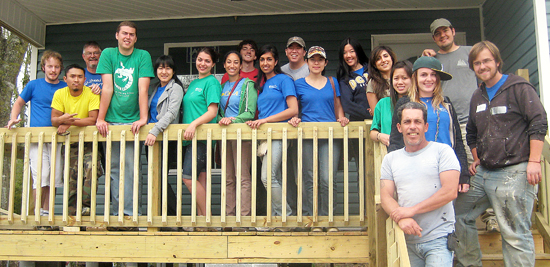For most students, spring break is a time to sit back, relax and enjoy a week off.
For Lilit Arabyan, however, spring break consisted of hammering nails, building a patio and learning how to use power tools as part of Habitat for Humanity’s Collegiate Challenge.
“I’d never picked up a power tool before, and now I can say I have at least three power tools under my belt,” said Arabyan, a second-year economics and global studies student.
Arabyan and 11 other students from Habitat for Humanity’s UCLA chapter traveled to Slidell, La., a town 30 minutes north of New Orleans.
There, they volunteered at a work site run by East St. Tammany, an affiliate of Habitat for Humanity that employs volunteers to build and renovate houses for people in need.
The Collegiate Challenge program offers groups of students an alternative break experience by providing the opportunity to spend a week working with one of 250 affiliate sites throughout the United States.
“In college, breaks are usually surrounded by just relaxing or having fun or playing around,” said Jamie Mei Cheng, president of UCLA’s Habitat for Humanity. “I think the students who go on these trips are just interested in a different kind of spring break.”
At the East St. Tammany work site, the team worked eight hours a day for four days, helping to build a patio on a house for Gigi, a local woman who lost her home when Hurricane Katrina hit.
“I don’t think there’s anything better than the gratitude you get when you try to help out,” Arabyan said. “The moment we met Gigi, just the way that she greeted us was worth every second of the trip.”
Five years after Hurricane Katrina, much of the area surrounding New Orleans is still in need of rebuilding, Arabyan said.
“What happens with these natural disasters like with Haiti and Chile, is that for a brief moment in time, all the public’s attention is there, but when the next thing comes along, we move along, unfortunately,” she said. “But actually being there and passing through the streets, there’s so much work that needs to be done that you just don’t know about.”
Working with the team at the site was a combination of caravanners who travel throughout the year and make stops at build sites, Arabyan said.
“I don’t think I’ve ever met such kind, generous people. One of the workers I met has a job that he works seven days a week, and on his weekend off he came to our site to help out. I thought that was amazing,” Arabyan said.
Interacting with the local people both on the work site and off gave the team the opportunity to experience a local perspective of New Orleans, fourth-year psychobiology and anthropology student Mandip Kaur said.
“It wasn’t the tourist experience of just going to see the French Quarter,” Kaur said. “We got to learn about the people. On one of our last days there, we had a crawfish boil, and it was awesome because we got to talk to the locals and got to learn who they were.”
A night out at a bowling-alley-turned-dance-floor and a trip to a local vegetarian restaurant in downtown New Orleans were only a few of the experiences that balanced out the long work days, Arabyan said.
“We worked hard, and we partied hard too,” Arabyan said. “This might sound a little cliche, but this trip was a life-changing experience. I think most of us went into this expecting it to be so different and so amazing, and it really was.”
